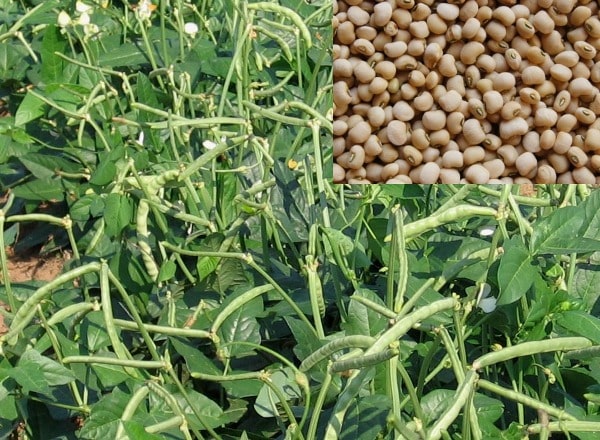Characteristics of Legumes
The grain legumes are members of the family Fabaceae (sub-family Papilionoideae).
They are mainly herbaceous plants although some are shrubs.
They possess stems or vines that are upright, semi-prostrate, or prostrate.
Cowpea Root System
They possess a taproot system with laterals. Many species of legumes have nodules in their roots containing bacteria that have the power of fixing atmospheric nitrogen, some of which are then available to the host plant, and the soil nitrogen is increased by soughed disintegrating nodules.
In return, the bacteria are supplied with carbohydrates by the host.
The bacteria, Rhizobium app., which are normally free-living in the soil when they do not fix nitrogen, are attracted to the roots of legumes from the seedling stage onwards.
They enter through the root hairs and pass into the cortex. Here they cause the cells to divide.
These cells are tetraploid and produce nodules, which appear on the surface of the roots.

The size and shape of the nodules vary considerably, but their form is constant for each species of legume.
Effective nodules contain red leghaemoglobin, which can be seen on cutting them across.
Ineffective nodules are usually small, hard, spherical, and greenish inside.
If nodules are ineffective, the bacteria may be parasitic on the host for nitrogen and the legumes must obtain their nitrogen from the soil, in which case they deplete the nitrogen reserves quicker than cereals and grasses.
Cowpea Leaves
The leaves are usually alternate and compound; trifoliate or pinnate. A fairly common feature throughout the family is the presence of a pulvinus at the base of the leaflets and petiole giving a degree of flexibility to the various parts of the leaf.
The flowers are mostly hermaphrodites with five sepals and five petals.
The ovary is superior with a single carpel, bearing a single row of ovules.
This is surmounted by a bent style, the tip of which broadens out into the stigmatic surface.
The flowers are subtended by bracts, which vary in size and degree of persistence.
The structure of the flower has a resistance to a butterfly.
Cowpea Fruits and Seeds
The fruit is usually a legume or pod, splitting along dorsal or ventral sutures or both; sometimes indehiscent as in groundnut.
The fruits are many-seeded but in a few species, maybe one-seeded.
The seeds vary in size, shape, and color; endosperm is usually absent.
Legumes are next in importance to cereals as a source of human food and contain more protein than any other plant product.
Most are grown for their dry seeds and their low moisture content and hard testa permit storage over long periods.
Legumes cultivated especially for their mature seeds for human consumption are called pulses or grain legumes, but the immature seeds of the young pods and leaves are also eaten as vegetables.
The vegetative parts of grain legumes are commonly fed to livestock after their seeds have been harvested; species that are cultivated only to feed livestock are called fodder or forage legumes, or if they are grown in mixtures with pasture grasses, pasture legumes.
Forage or pasture legumes will not be considered here. The most commonly grown legume crops are grown in the tropics to be considered are cowpea, groundnut, pigeon pea, and soybean.







